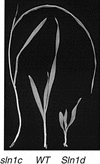Mutants at the Slender1 locus of barley cv Himalaya. Molecular and physiological characterization
- PMID: 12011349
- PMCID: PMC155882
- DOI: 10.1104/pp.010917
Mutants at the Slender1 locus of barley cv Himalaya. Molecular and physiological characterization
Abstract
A dominant dwarf mutant of barley (Hordeum vulgare) that resembles dominant gibberellin (GA) "-insensitive" or "-nonresponsive" mutants in other species is described. alpha-Amylase production by endosperm half-grains of the mutant required GA3 at concentrations about 100 times that of the WT. The mutant showed only a slight growth response to GA3, even at very high concentrations. However, when additionally dwarfed, growth rate responded to GA3 over the normal concentration range, although only back to the original (dwarf) elongation rate. Genetic studies indicated that the dominant dwarf locus was either closely linked or identical to the Sln1 (Slender1) locus. A barley sequence related to Arabidopsis GAI/RGA was isolated, and shown to represent the Sln1 locus by the analysis of sln1 mutants. The dominant dwarf mutant was also altered in this sequence, indicating that it too is an allele at Sln1. Thus, mutations at Sln1 generate plants of radically different phenotypes; either dwarfs that are largely dominant and GA "-insensitive/-nonresponsive," or the recessive slender types in which GA responses appear to be constitutive. Immunoblotting studies showed that in growing leaves, SLN1 protein localized almost exclusively to the leaf elongation zone. In mutants at the Sln1 locus, there were differences in both the abundance and distribution of SLN1 protein, and large changes in the amounts of bioactive GAs, and of their metabolic precursors and catabolites. These results suggest that there are dynamic interactions between SLN1 protein and GA content in determining leaf elongation rate.
Figures






References
-
- Chandler PM. Hormonal regulation of gene expression in the “slender” mutant of barley (Hordeum vulgare L.) Planta. 1988;175:115–120. - PubMed
-
- Foster CA. Slender: an accelerated extension growth mutant of barley. Barley Genet Newslett. 1977;7:24–27.
Publication types
MeSH terms
Substances
LinkOut - more resources
Full Text Sources
Other Literature Sources
Molecular Biology Databases

